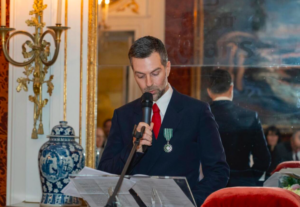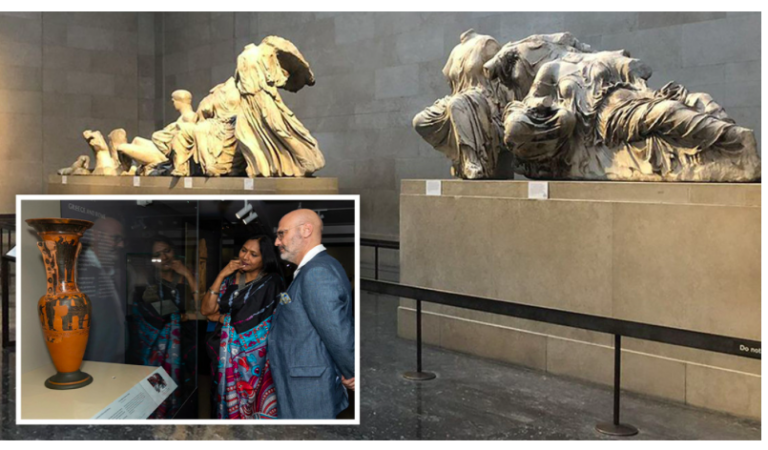It is noon on Tuesday, January 30, 1996. A live broadcast on nearly all Greek television stations shows the departure of the armored Greek fleet from the Salamis Naval Station. The warships are heading towards Imia, the rocky islets that have brought Greece and Türkiye to the brink of war. While the TV cameras capture the movement of the fleet, they fail to convey the tension among the crews or the intense backdrop of those fateful days—days that ended in tragedy, with the loss of officers Vlahakos, Karathanasis, and Gialopsos, and the “greying” of areas in the Aegean.
Twenty-nine years later, the Imia crisis remains a defining moment in Greek-Turkish relations. Despite the passage of time, many aspects of the crisis remain shrouded in mystery. What really happened during those critical hours? What became of the key figures involved? Over the years, real events have merged with speculation, giving rise to urban myths that persist on both sides. What, then, is the truth?
The “Accidental” Landing
On December 25, 1995, the aging Turkish freighter Figen Akat (built in 1973) ran aground near Mikri Imia. No one could have predicted that this seemingly minor maritime incident would escalate into a full-blown crisis.
At the time, Greek politics were dominated by internal issues: the serious illness of Prime Minister Andreas Papandreou, the power struggle between Simitis and Tsochatzopoulos for his succession, and Greece’s announcement of an EU-subsidized program for the settlement of rocky islets. In Türkiye, the True Path Party had placed third in the elections, but Tansu Çiller remained Prime Minister. Meanwhile, Turkish officials saw Greece’s rocky islet settlement program as an attempt to expand its continental shelf—a development largely overlooked in Athens.
When the Figen Akat, en route from Çanakkale to Israel, became stuck on the rocks, its captain refused Greek assistance, claiming the ship was in Turkish waters and requesting help from the Turkish Coast Guard. Greek press officer Ioannis Papameletiou contacted the Turkish Foreign Ministry, urging them to allow Greek tugs to intervene, but Ankara responded with an unexpected claim: beyond the immediate rescue operation, there was now a “general issue of ownership” regarding Imia.
On December 28, the Figen Akat was successfully towed to safety by Greek tugboats and escorted to the Turkish port of Kuşadası. But by then, the seeds of crisis had been sown. To this day, some question whether the freighter’s grounding was truly accidental.
The Figen Akat, later renamed Cem Sultan, Arda Akansu, and Mersa 2, suffered another maritime misfortune years later. In June 2012, it collided with rocks and ran aground in Italy. By early 2013, the ship that had sparked the Imia crisis was scrapped in a Turkish dismantling yard.
The Intelligence Chiefs
During the crisis, the heads of the Greek and Turkish intelligence services played pivotal roles. Their responsibility was to provide timely and critical intelligence on the movements and intentions of the “opposite” side.
In Greece, the National Intelligence Service (EYP) was headed by Admiral Leonidas Vasilikopoulos, a close associate of Papandreou and a key figure during the 1987 “Sismik” crisis. However, he had been sidelined by newly appointed Prime Minister Kostas Simitis. As a result, crucial intelligence on Turkish patrol boats near Imia on January 29, intercepted communications, and warnings about potential landings were not fully acted upon.
On the night of January 30, while Greece’s military and political leadership gathered in the Prime Minister’s office instead of the Pentagon’s operations center, Vasilikopoulos was left outside, repeatedly requesting to brief Simitis. At one point, he banged on the door, demanding entry. When he was finally confronted by Interior Minister Akis Tsochatzopoulos, he delivered chilling news: “Turkish commandos have landed on Imia.” By then, however, Greek and Turkish media had already reported the development.
In Türkiye, the head of the National Intelligence Organization (MIT), Kaşıf Kozinoğlu, played a significant role in managing the crisis alongside Prime Minister Çiller. A veteran operative, Kozinoğlu had extensive experience in the Middle East and Central Asia. However, his career took a dramatic turn in 2011 when he was arrested as part of the Ergenekon investigation, accused of conspiring with Fethullah Gülen. On November 13, 2011, just hours before testifying in court, he suffered a fatal heart attack in prison. His death remains controversial, with some suspecting poisoning. Today, his name resurfaces in Türkiye, with nationalist circles labeling him a hero.
The Commandos and the Helicopter Crash
For years, rumors have persisted about whether any Turkish commandos involved in the Imia landing later died in a mysterious helicopter crash, allegedly due to “Greek sabotage.”
Hakan Gürkan, the commander of the SAT (Turkish Special Forces) unit that landed on Imia, has claimed in interviews that Türkiye “won the crisis without firing a single bullet” but lost five commandos when a helicopter crashed near Aksaz Naval Base fifteen days later. Other accounts, including that of Lieutenant Ali Türksen—the leader of the 12-man team that landed on Imia—suggest the crash occurred during a routine patrol. Türksen, now 59, has maintained that no shots were fired at the Greek Navy helicopter that crashed that night.
That helicopter, an AB 212, took off from the Greek frigate Navarino with Lieutenant Christodoulos Karathanasis, co-pilot Panagiotis Vlahakos, and flight technician Hector Gialopsos aboard. They reported spotting ten Turkish commandos and a Turkish flag on western Imia before losing contact. The Navy concluded that the crash resulted from vertigo and adverse weather conditions, though speculation of enemy fire remains.

The Journalists
On January 27, 1996, Hürriyet journalist Cesur Sert, accompanied by a cameraman from Kanal D, landed a rented helicopter on Imia, replacing the Greek flag with a Turkish one. This provocative act further inflamed tensions.
Sert, once hailed as a hero in Türkiye, later abandoned journalism amid rumors of MIT affiliations. In an interview with Proto Thema, he expressed regret: “I feel remorseful about what happened. There were problems then, and there will be in the future, but we are neighbors. We should live side by side, increasing contacts in trade, tourism, and culture rather than fueling tensions.”
The Legacy
The Imia crisis remains a defining moment in Greek-Turkish relations. The loss of three Greek officers, the geopolitical implications, and the urban myths that have emerged continue to shape the discourse on both sides of the Aegean. As history inches toward the three-decade mark, the question remains: how much of the truth is still hidden in the “grey zones” of the Aegean?
Ask me anything
Explore related questions





